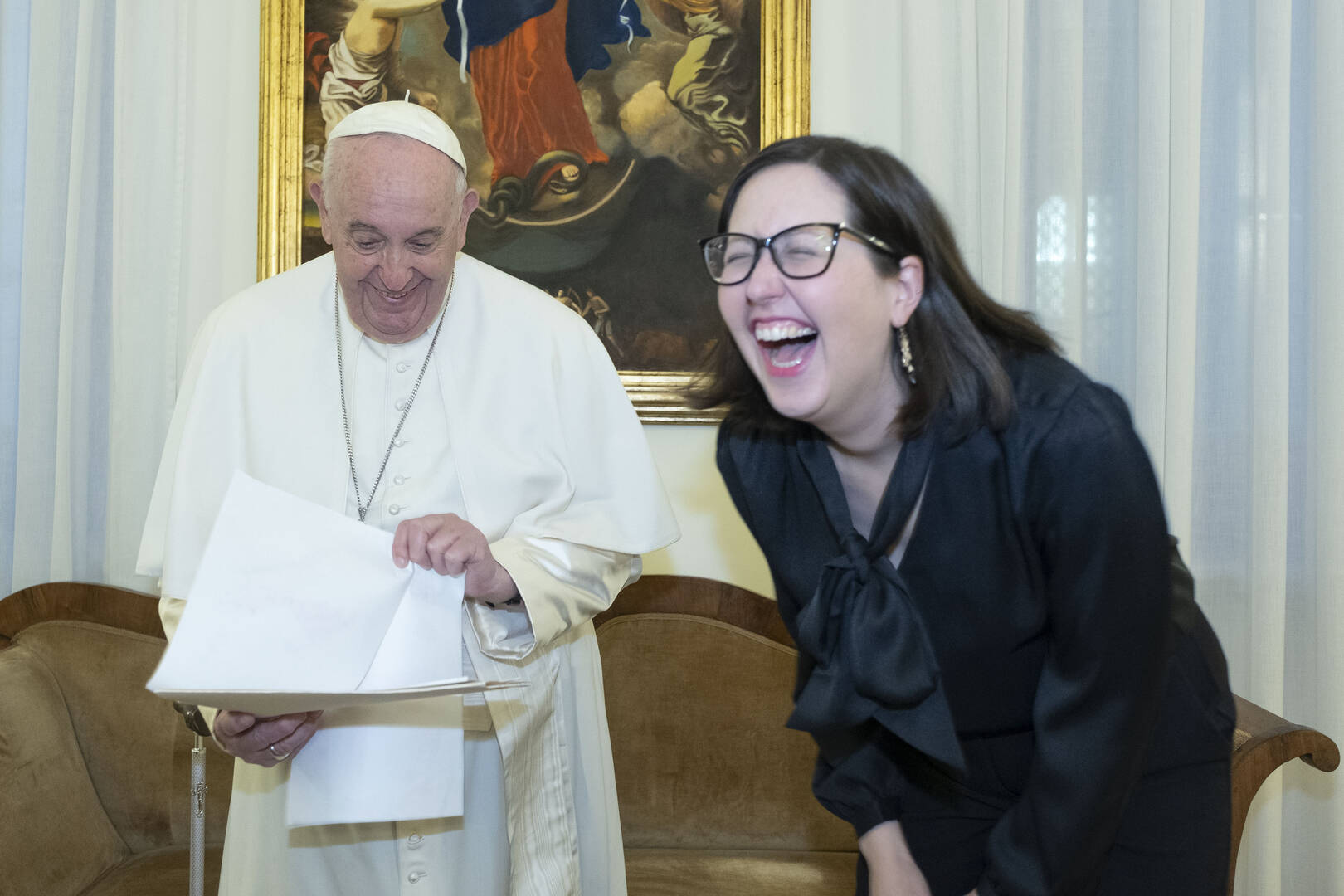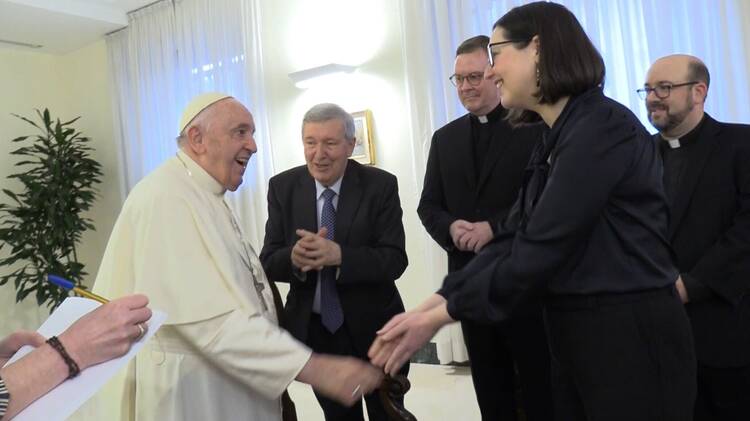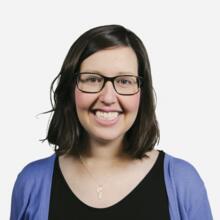One of the first things I do when I enter Casa Santa Marta is take off my shoes. It has rained almost all day, and the cobblestones of Rome are wet and slippery; there is no way I would have survived the walk from my hotel to the pope’s home in heels. I change out of my black flats and into red pumps that are more of a stylistic nod to Benedict than Francis. But it is Pope Francis we are here to see. And we are thrilled.
The days leading up to our interview have been filled with a sort of triage, sorting what matters from what does not; what we have time for from what we do not. My colleagues and I discuss questions for the pope and our travel itineraries. We discuss photographers and translators, WhatsApp group chats and dinner plans.
My husband and I also figure out how to make the puzzle of each day fit together while I am gone (hint: my saintly mother plays a very large role). My children will need to get to and from school. My in-laws will arrive from Ireland for their first visit in years. The Thanksgiving pies will need to be picked up from the farm-stand bakery.
I have asked my older son and daughter what they think the pope should know or what they want to tell him. My 6-year-old wants to know the pope’s favorite animal, and my ever-wise 4-year-old wants him to know that play is important. They have drawn the pope pictures, as have their cousins. The 6-year-old has drawn the logo of the PBS show “Wild Kratts,” along with an ocelot, a leopard and a Komodo dragon. He writes his first name and his favorite color, summing up all the relevant info a first grader needs to form a friendship. The 4-year-old draws a red cross and red hearts and candles and little people holding the crosses. My 2-year-old draws a red scribble, which I can only assume is a theologically advanced yet abstract reflection on Pentecost.
One of the strangest things about sitting face to face with Pope Francis is how normal it feels.
In the hours before my flight from Hartford to Rome, I begin to worry that I do not have the right shoes, even though I know that it does not matter what shoes you wear to meet the pope. Or perhaps it matters so far as your attire may be used to show respect (or not), but it does not matter in a Jesus-will-ask-you-about-it-at-the-last-judgment kind of way. Yet, on my way to the airport, while my husband and kids waited in the car, I sprinted into a DSW and scanned the shelves. I grabbed a pair of “poppy” colored “microsuede” heels and then rushed to the register. Because, as important as the shoes then seemed, making the flight was moreso.
There has been so much going on, so many people to plan for, that it is not until the night before the interview, when Father Sam Sawyer and Gloria Purvis and I stand in the middle of St. Peter’s Square that I really allow it to sink in that I will have the chance to meet our church’s first Jesuit pope. As we eat gelato on a chilly night, surrounded by a cloud of witnesses cut in stone atop the nearby walls, I hope that some part of the next day’s conversation will help to build our church.
The next morning, there is little pomp to entering Santa Marta. We simply pass by a few Swiss Guards in rain gear and some gentlemen who help us hang up our coats. After the shoe swap, we walk through double doors to the room where we will speak to Pope Francis. It feels oddly familiar, like the lobby of a retreat house but with more velvet chairs. A huge painting of Our Lady Undoer of Knots watches over us as Father Sawyer sets up the audio equipment and the rest of us gather our notes.
Moments later, the doors open and Pope Francis walks in leaning on a wheeled walker, the kind with the little seat and the mesh basket underneath. In the basket is a cane, stored at a diagonal, with a little silver crucifix wrapped near the top. No one announces his arrival and he seemingly appears in our midst like the Holy Spirit in the locked room.
I can simply be with him, notice how he looks at people when they talk to him. How he pays attention. His laugh. I find it remarkable how much I feel like I understand him, even when I don’t understand all his words.
One of the strangest things about sitting face to face with Pope Francis is how normal it feels. How, despite the unusual surroundings and company we’re in, the pope makes us feel at home in his home.
I thought that I would be nervous, that I’d stumble more than usual over my words, or literally stumble in my heels. But instead I feel calm. Which is a marked contrast to 3:30 that morning when I had called my mom from my hotel room because I couldn’t sleep thanks to my nerves. “Just say to yourself: Not me, but God through me, because that’s all it is anyway,” she says shortly before settling in to watch NCIS in real time. “Just say, ‘Holy Spirit be with me,’ and go.”
I catch parts of what Francis says in Spanish, but rely on Elisabetta Pique, our translator, for the full answers. There is a frustrating element to the gap between my hearing and understanding, but there is also something freeing. It gives me the chance to simply observe. I do not analyze Francis’ words or wait impatiently to respond. I can simply be with him, notice how he looks at people when they talk to him. How he pays attention. His laugh. I find it remarkable how much I feel like I understand him, even when I don’t understand all his words.
Being near Francis made me want to love people more and love more people.
Being near Francis made me want to love people more and love more people. The experience made me feel a deep bond to the people beside me in the room. But being with him also kindled a desire to extend that bond to others. To look to them the way Francis looked to us: open, loving, joyful, vulnerable. Willing to show weakness and honesty and to dwell in the messiness. The excitement I felt with Francis has continued to grow the more I reflect on my time with him.

After the interview, I give Pope Francis my kids’ drawings and to my surprise he seems genuinely delighted. “For me?!” he asks as his face lights up. “Sí!” I say as he flips through them and then stores them in the basket of his walker. He does not have a favorite animal but jokes that maybe he is “a concentration of all the animals.”
I laugh, throwing my head back. But his comments also make me think of how much pressure we put on him, how much so many of us expect him to be everything to everyone. How hard it must be on him and how joyful he manages to be in the midst of it.
Being at the Vatican and in the midst of all the beauty that is part of it—in the Sistine Chapel, in the Scavi, in St. Peter’s Basilica and in the pope’s own home—gave me a greater appreciation for the role of the papacy. But it also helped me appreciate the limits of the office. Talking to Francis is a lot like talking to your mother at 3:30 a.m. It makes you feel like everything will be O.K., but you know there’s a lot you still have to figure out.
I think there is a part of me that went into the interview looking for answers, not just to our questions but to the sort of doubts that arise from just being a part of a church filled with sinners and from being one myself. But over and over, Francis pointed us back to the important questions, the ones that come from a close reading of the Beatitudes and Matthew 25. Some part of me hoped that the interview would help teach me how to be more like Francis. But it’s clear the only thing he wants is for us to want to be more like Jesus.










